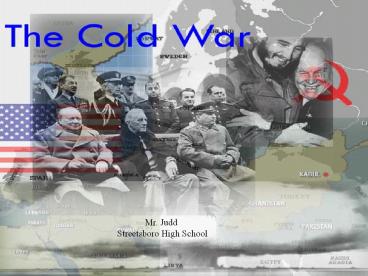Cold War PowerPoint PPT Presentation
1 / 25
Title: Cold War
1
Mr. Judd Streetsboro High School
2
YALTA (Feb 1945) Present Churchill, Roosevelt
and Stalin
Create a United Nations organization
Prosecution of War Criminals
Germany divided into 4 zones of occupation
Free Elections In Europe
3
POTSDAM (Germany) Date July 1945 Present
Churchill, Truman and Stalin
Soviets discuss joining war against Japan. The
U.S. is not sure thats a good idea. Why?
Truman learns about the atomic bomb. Does not
tell Stalin.
U.S. And Soviets disagree about German
reparations.
4
U.S. and Soviet soldiers meet at the Elbe River
near the end of World War II. Why did these
allies become bitter enemies for the next 45
years?
5
Introduction
Cold War The state of hostility, without direct
military conflict, that developed between the
U.S. and the Soviet Union after WWII and lasted
until 1990.
6
I. Origins of the Cold War
The origins of the Cold War lay in
profound economic, political, and philosophical
differences between the two nations.
7
(No Transcript)
8
II. The Early Cold War Years
- The conflicting aims in Germany and Eastern
Europe led to tension between the United States
and the Soviet Union after World War II.
9
The Iron Curtain Descends
- Stalin installed communist governments in
Albania, Bulgaria, Czechoslovakia, Hungary,
Romania, and Poland. - These countries became known as satellite
nations, countries dominated by the Soviet Union. - The phrase iron curtain came to stand for the
division of Europe.
10
United States establishes a policy of
containment.
- Taking measures to prevent any extension of
communist rule to other countries. - This policy will serve the United States
throughout the Cold War.
11
Truman Doctrine 1947
- What Gives military help to free countries that
communists are trying to take over. - Why The Domino Theory If one country falls to
communism, the neighboring countries will fall
too.
12
Marshall Plan 1948
- What Gives U.S. money to free countries to
rebuild homes, factories, and farms. - Why To make countries strong enough so they will
not need Communist help.
General George C. Marshall
13
Superpowers Struggle over Germany
At the end of World War II, Germany was divided
into four zones occupied by the U.S., G.B.,
France, and the U.S.S.R.
14
Berlin Airlift 1948
After plans to reunify Germany ended in
failure, the Soviet Union blockaded all
land routes into West Berlin. The U.S. and
G.B. responded with an airlift. For 327
days, planes delivered 2.3 tons of supplies to
West Berlin.
15
The NATO Alliance 1949
The U.S., Canada, Iceland, and nine European
Nations form a defensive military
alliance called the North Atlantic Treaty
Organization.
16
The Chinese Revolution 1949
After WWII, civil war erupted between Chinese
Communists and Chinese Nationalists. U.S. aid
was not enough to save the Nationalists as they
were forced to retreat to the island of Taiwan
in 1949. After more than 20 years of struggle,
the Communists now ruled all of mainland China.
Chiang Kai-shek Nationalist
Mao Zedong Communist
17
The Korean War 1950
Only five years after WWII ended, the U.S. became
embroiled in a war in Korea. The policy of
containment had led the U.S. into battle to halt
communist expansion. In this con- flict, however,
the enemy was not the Soviet Union, but
North Korea and China.
18
III.The Cold War and American Society
During the late 1940s and early 1950s, fear
of communism led to reckless charges
against innocent citizens. The House Un- American
Activities Committee (HUAC) investigated
alleged communist activities in Hollywood.
19
Spies Among Us
Ethel and Julius Rosenberg were executed in
June 1953 for allegedly giving the Soviet Union
atomic bomb secrets. They became the first U.S.
civilians executed for espionage.
20
Mc Carthy Launches His Witch Hunt
In the early 1950s, Senator Joseph McCarthy of
Wisconsin began accusing members of the state
department of being communists. Since that time,
McCarthyism has referred to the unfair
tactic of accusing people of dis- loyalty without
providing evidence.
21
Bomb Shelters
The threat of nuclear attack led Americans to
build bomb shelters and practice air-raid
drills. Fear of nuclear war became a constant in
American life for the next 30 years.
22
Duck and Cover
1951 Civil Defense Duck and Cover Film
23
IV. Eisenhowers Cold War Policies
President Eisenhower believed that maintaining a
large army was too expensive. Instead, he
favored a massive arms buildup. Nuclear weapons,
he said, gave more bang for the buck. His
willingness to use nuclear weapons to maintain
world peace was called massive retaliation.
Critics called this brinkmanship- the
willingness to go to the brink of war to force
the other side to back down- and argued that it
was too dangerous.
24
Sputnik launches a Space Race 1957
On October 4, 1957, The Soviets launched Sputnik,
the worlds first artificial satellite. Sputnik
traveled around the earth at 18,000 miles per
hour, circling the globe every 96 minutes.
25
U-2 Is Shot Down 1960
In 1960, the Soviets shot down an American U-2
spy plane. The pilot, Francis Gary Powers, was
forced to parachute into Soviet-controlled territo
ry. The Soviets sentenced Powers to ten years in
prison.

